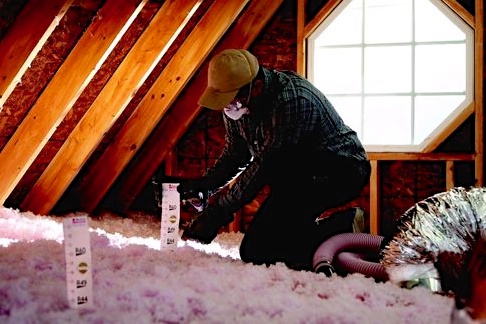
By keeping the heat in and the cold out, insulation is a crucial component of a comfortable, welcoming home. Photo: Alcal Specialty Contracting, Inc. ©2019
I’ll admit, I like being greeted at the front door. For me, the home environment is the hug that wraps me in a warm embrace on a rainy day or the kiss of cold that greets me at the door when it’s over 100 degrees outside. That’s my kind of “welcome home.”
Unfortunately, my home is insulated to 1970 building code standards, so I’d be surprised if it even had insulation in the attic (I’m afraid of the attic, so I’m not going to check). My home’s exterior walls aren’t insulated and the windows are single-pane, aluminum-framed, and leaking air in all the wrong directions. There’s a fireplace but it doesn’t warm the air in front of it. I have a tapestry hanging in the living room—I can literally see it swaying in the breeze of the winter draft.
After living in this home for nine years, I’ve come to the conclusion that there’s no point in running the heater (and paying for it) because within a minute, my home is cold again. So, last year, I went the entire winter without turning on the furnace once. As a result, I can offer the following list of ways to stay warm:
- Work out or clean the house
- Forget things upstairs when you need them downstairs and go get them (repeat as necessary)
- Bake something
- Eat spicy food
- Wear many of the clothes and wool hats you own
- Snuggle up to a big dog
- Get under an electric blanket
A Better Solution
This year, I’m shopping for insulation. Here’s what I’m learning about my situation:
When it’s cold outside, my home loses heat through conduction, convection, radiation and infiltration. Basically, my under-insulated home is nothing more than a windbreaker.
Since I live in a townhome, I want my insulation to double as soundproofing material. The Sound Transmission Coefficient (STC) scores materials based on the amount of noise transmission through a barrier—the higher the number, the better. All residential insulation in California must have a Class 1 Fire Rating. Some products aren’t combustible but can melt; others are treated with a fire retardant. All of the materials listed below meet that requirement. So, I’ve compared the following:
Fiberglass vs. Cellulose
Fiberglass
R-value: 3.7/in
Material: Molten glass including recycled content
Installation method: Rolls/batts or blown-in
Soundproofing: STC 43
Cellulose
R-value: 3.6-4.0/in
Material: 85% recycled paper, treated with fire retardant
Installation method: Blown-in
Soundproofing: STC 70
Rockwool vs. Open-Cell Spray Foam
Rockwool
R-value: 3.3/in blown-in and 4.2/in batts
Material: Lava! (Technically, fibers spun from liquid basalt and a steel manufacturing byproduct.)
Installation method: Batts and blown-in
Soundproofing: STC 52
Open-Cell Spray Foam
R-value: 3.7/in
Material: Polyurethane
Installation method: Spray (This is particularly suited for preventing air leaks in nooks and crannies. As with any spray-in insulation, you need to be mindful about displacing existing plumbing and wiring.)
Soundproofing: STC 37-39
Cotton/Denim vs. My Old Jeans
Cotton/Denim
R-value: 3.7/in
Material: Waste cotton denim from factories
Installation method: Batts
Soundproofing: STC 40-52
My Old Jeans
Layering my attic with my old size 3s will provide insulation and free up space in my closet, but I might fit into these again, so…
At the moment, I’m leaning toward rockwool or cotton/denim. Before you decide which type of insulation is best for your situation, be sure to check out manufacturing data related to fire rating, pros and cons, R-value, and sound transmission. And may you too have a welcoming home in all the seasons.
Find an insulation contractor in your area.
